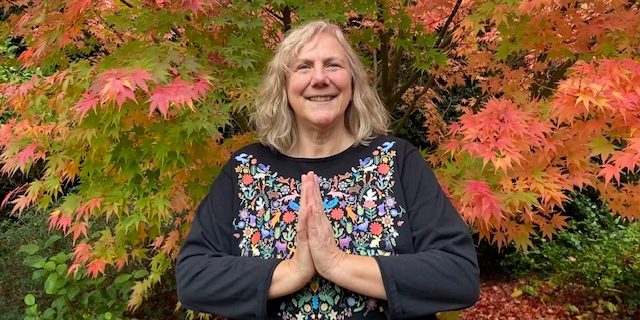Yoga’s Unique Approach
Why is Yoga different from other forms of exercise and how does it facilitate healing? Why do students leave Yoga feeling energized yet calm? The goal of Yoga is beyond stretching hamstrings, losing weight or building muscle mass. The sister sciences of Yoga and Ayurveda function together as an integrated wellness system. The blending of asana, pranayama and meditation creates an efficacious practice, regardless of age or physical limitations. The ancient texts teach us the three main purposes of Hatha Yoga:
- To purify the body
- To balance physical, mental and energetic aspects
- To engage in physical practices that lead to higher consciousness

Health Benefits of Yoga
As Yoga becomes more ubiquitous throughout the world, doctors and scientists are researching the physiological and psychological effects of Yoga. Acknowledged health benefits include:
- Improves posture, balance and eye-hand coordination.
- Tones the body, stretches and strengthens muscles, creating more flexibility and agility.
- Reduces bone-thinning and the risks of osteoporosis.
- Lubricates joints and improves range of motion.
- Reduces stiffness, aches and pains related to inactivity.
- Calms mind and body; promotes relaxation and regulates sleep cycles.
- Improves concentration and focus.
- Encourages mindful eating and a sattvic lifestyle.
- Improves body systems, including respiration, circulation and digestion.
- May lower blood pressure, cholesterol and blood sugar.
- Balances energy, hormones and boosts endurance and immunities.
- Improves a sense of well-being and cultivates gratitude.
Asanas and their Effects
Seated meditation prepares the body for movement, balances breath and energy and focuses the mind inward and into the present moment.
Moving in and out of poses stretches the muscles, while staying in a pose is strengthening. Standing poses with longer holds build bone and muscle mass.
Spinal twists aid in release of toxins and create more flexibility in the spine.
Seated and standing forward bends and Apanasana, massage abdominal area and aid in digestion.
Back bends (chest openers) aid in respiration.
Grounding, restorative poses calm the sympathetic nervous system and activate the parasympathetic nervous system.

Yoga is a moving meditation regulated by the breath.
Yoga teachings describe the physical, subtle and causal bodies (shariras) and five sheaths (koshas) bound together by wheels of energy (chakras). The subtle body is composed of energy, mind and intellect. Prana (breath, life force) flows through energy channels (nadi). Pranayama controls breath and energy and opens the nadi to access healing throughout the body.
Moving faster between asanas builds more heat and energy (brahmana), while slower transitions lead to a gentler, more mindful practice (langhana). Body and breath awareness increase with persistent practice and each Yogi/ni learns to adjust for time of day, vitality and other considerations.
Finding Balance
According to Ayurveda and Yoga, wellness is defined as the balanced and dynamic integration between environment, body, mind and spirit. All matter is composed of five elements (earth, water, fire, air and space). The elements combine into three basic energies (doshas) – vata, pitta and kapha. Each person has a unique constitution (prakriti) composed of the doshas.
One primary goal of an Ayurvedic Yoga practice is to balance the doshas. To maintain balance and find wellness use the principle of opposites. For example, on a cool damp day, practice with more movement and standing postures to increase energy and heat. Conversely during the heat of summer, practice in the morning or evening with more grounding, restorative poses. People with a Vata constitution may benefit from a langhana practice, while those with a Kapha constitution may benefit from a brahmana practice.

The Eightfold Path
Many students come to Yoga to stretch or reduce stress, then discover the deeper teachings, including the ashtanga (eightfold) path of Yoga. Healing and transformation are experienced through a full practice embracing all eight limbs of Yoga.
- Yama – worldly restraints and ethical standards
- Ahimsa – nonviolence
- Satya – truthfulness
- Asteya – non-stealing
- Brahmacharya – pure way of life
- Aparighaga – non-possessiveness
- Niyama – personal restraints
- Shauca – purity, cleanliness
- Santosha – contentment
- Tapas – self-control, self-discipline
- Svadhyaya – study of the scriptures, deeper meanings, philosophy
- Ishavara pranidhana – surrender to a higher force; pure seeing
- Asana – physical postures; purify the body and prepare for meditation
- Pranayama – control of the vital force (breath)
- Pratyahara – withdrawal of the senses
- Dharana – concentration
- Dhyana – meditation or contemplation
- Samadhi – absorption in the object of meditation; complete realization
When the body is cleansed, the mind purified and the senses controlled, joyful awareness, needed to realize the inner self, also comes.
~ Yoga Sutras
This post was written as part of a collaboration with Chinmay Yoga. Learn more about this non-profit Yoga school in Kangra, Himachal Pradesh, India on their website and Facebook page. Their blog has both educational and inspirational articles about Yoga.


One thought on “Healing with Yoga from the Inside”